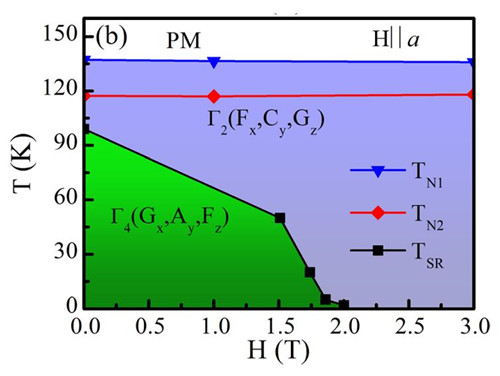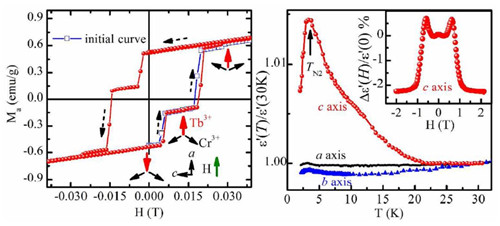Recently, researchers from Institute of Solid State Physics, Chinese Academy of Sciences, Institute of Functional Physics, Institute of Solid State Physics, Yin Lihua, and other researchers have made new progress in magnetic and magnetoelectric effects of perovskite-type Cr-based oxides. Related results were published in Applied Physics. Letters and other journals. Magnetism is the basic attribute of matter. Magnetic materials are widely used in modern science and technology such as information storage and magnetic refrigeration, production and life. RCrO3 (R= rare earth element) and its Fe doping system with a simple perovskite structure have strong magnetoelectric effects, but also show a large magnetocaloric effect and temperature-induced magnetic moment inversion, etc., have been in recent years More and more attention. However, the microcosmic mechanism is not yet clear, and even the observed magnetoelectric effect in this system is still controversial. Therefore, systematically studying the magnetic and magnetoelectric effects of the system has important scientific significance, helps to understand the microscopic mechanism, and explores new magnetic functional materials and magnetoelectric materials. The Hefei Research Institute of Solids Research Institute has a series of Fe-doped RFe0.5Cr0.5O3 (R=Y, Sm, Nd, Dy, Gd, etc.) polycrystalline, RCrO3 (R=Gd, Tb, Dy, Er, Nd, etc.) ) and its doping system single crystal magnetoelectric effect of a systematic study. Studies have found that Fe-doped RFe0.5Cr0.5O3 (R=Y, Sm, Nd, Dy, Gd, etc.) systems, in addition to giant magnetocaloric effect, temperature-induced magnetic moment inversion, only change the size of the applied magnetic field without changing the magnetic field. In addition to the phenomenon of magnetic moment reversal in the direction, two successive dielectric relaxation behaviors are also exhibited below room temperature. The analysis shows that the temperature-induced magnetic moment inversion phenomenon in this system is not only related to the magnetic interaction of R-Cr/Fe, but also closely related to the magnetic interaction of Fe-Cr. The two dielectric relaxations occurring at low temperatures are related to the electrons jumping in the Cr-rich and Fe-rich clusters, respectively, where the Cr/Fe-rich clusters are caused by Fe/Cr disorder in the system. Related studies have been published in the magazines Materials Research Bulletin and Applied Physics Letters. In order to further study the microscopic mechanism of the magnetoelectric effect of RCrO3 system and temperature-induced magnetic moment inversion, the researchers grew a single crystal of RCrO3 (R=Gd, Tb, Dy, Er, Nd, etc.) and its doping system. sample. Through the in-depth study of its magnetic and magnetoelectric effects, it is found that the magnetic properties of the system vary greatly due to the change of rare earth element R, but it has a strong intrinsic magnetoelectric coupling effect at low temperatures. (1) GdCrO3 single crystal: Two consecutive temperature-induced magnetic moment inversion phenomena were observed in this single crystal, and a new phenomenon of temperature-induced magnetic moment discontinuous jump was also found. These magnetic phenomena are closely related to the Gd-Cr spin interactions in GdCrO3 single crystal materials. In addition, the single crystal exhibits a very large magnetocaloric effect at low temperatures and its value is as high as ~242 mJ cm-3 K-1, which is much higher than that of other rare earth alloys (eg, HoCoAl, etc.) and Gd-based garnets Gd3Ga5–xFexO12. Area of ​​magnetocaloric material. The relevant results were published in the Journal of Applied Physics. (2) TbCrO3, ErCrO3, and DyCrO3 single crystals: TbCrO3 and ErCrO3 single crystals exhibit magnetic field-induced magnetic moment hopping at low temperatures; ErCrO3 single crystals also have very large rotational magnetocaloric effects at low temperatures; single crystals of DyCrO3 and ErCrO3 The spin reorientation behavior of Cr ions and rare earth ions is exhibited at low temperatures. These phenomena are reported for the first time. The relevant results were published in the Journal of Materials Chemistry C. By replacing the Cr element of the RCrO3 system with magnetic elements, new magnetic interactions can be introduced to change the magnetic ground state and obtain some new magnetic and electrical properties. Based on this idea, researchers have grown Fe-doped single-crystal YCr1-xFexO3 (x=0.12) samples. The study found that due to the disordered occupancy between Fe and Cr and the strong magnetic interaction of Fe-Cr, This makes it exhibit magnetic field and temperature induced spin reorientation and other magnetic behavior that are different from YCrO3 and YFeO3 parent samples. Related work was published on Applied Physics Letters. This work was supported by the National Natural Science Foundation of China and the Frontier Science Key Research Project of the Chinese Academy of Sciences. Square Sliding Bar Set,Brass Rainfall Shower Set,Bathroom Square Sliding Bar Set,Wall Mounted Square Sliding Bar Set Kaiping Rainparty Sanitary Ware Technology Co.,Ltd. , https://www.rpshower.com
Figure 1. Temperature-Magnetic Phase Diagram of YCr0.88Fe0.12O3 Single Crystal 
Figure 2. Giant magnetocaloric effect in polycrystalline GdFe0.5Cr0.5O3 
Figure 3. Magnetic field-induced magnetic moment jump in TbCrO3 single crystal (left) and magnetoelectric effect in DyCrO3 single crystal (right)